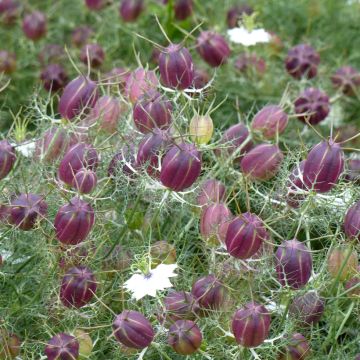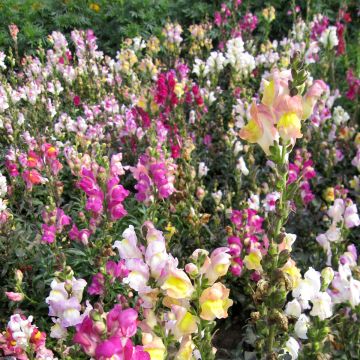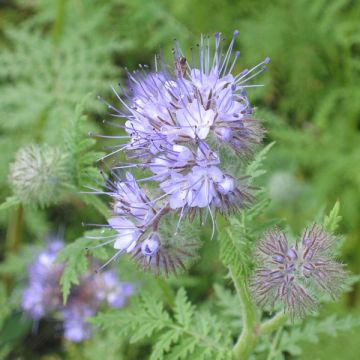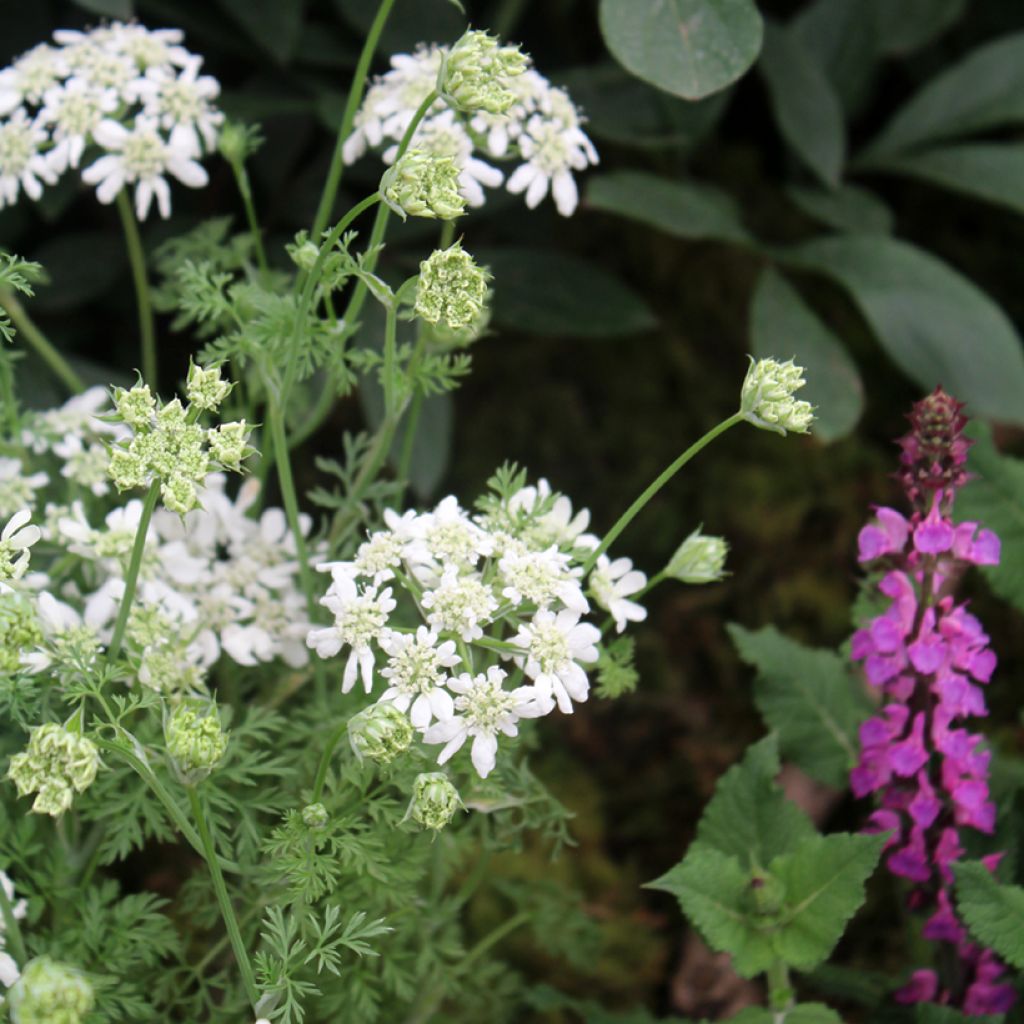

Orlaya grandiflora


Orlaya grandiflora


Orlaya grandiflora


Orlaya grandiflora


Orlaya grandiflora
Orlaya grandiflora
Orlaya grandiflora
White Laceflower
At my place, it's already flowering since early May and it reaches a height of 90 - 1 meter! While you advertise 30 cm... I sowed it at the edge of my flower beds... and I'm bothered, we can't see the plants behind it :((
Marta, 13/05/2024
This item cannot be shipped to the selected country
Dispatch by letter from €3.90
More information
Dispatch by letter from €3.90
More information
Schedule delivery date,
and select date in basket
This plant carries a 6 months recovery warranty
More information
We guarantee the quality of our plants for a full growing cycle, and will replace at our expense any plant that fails to recover under normal climatic and planting conditions.
Seed-only orders are dispatched by sealed envelope. The delivery charge for seed-only orders is €3.90.
Does this plant fit my garden?
Set up your Plantfit profile →
Description
Orlaya with large flowers, also known as Orlaya grandiflora is a beautiful wildflower, fond of dry and sunny areas. It stands out for the delicacy of its pure white umbels, as fine as lace. This annual blooms between June and August, forming light tufts of finely cut foliage. When conditions are suitable, it readily self-seeds in the garden. Essential in natural gardens, it enhances all the plants that accompany it, in borders or bouquets. It tolerates poor and rocky soils, as well as limestone and even clay soils if they are well-drained.
This annual from the Apiaceae family (Umbellifers) is a lover of limestone and clay areas and sunny rocky slopes. It is native to central and southern Europe, the Caucasus, and North Africa. This plant blooms in summer, from June to August-September, forming light tufts that reach a height of 20 to 40 cm (8 to 16in). Its slender stems are highly branched and bear flowers grouped in flat umbels, pure white in colour, with a diameter of 8 cm (3in), composed of 5 to 6 florets. The petals of the flowers arranged around the edge of the umbel are much longer than those of the central flowers, accentuating the lace-like appearance. The plant develops from a taproot. It initially forms a basal rosette, from which emerge stems covered with elegant and finely cut foliage, finer than that of its cousin, the carrot. The flowering gives way to ovoid fruits, measuring up to 8 mm (0.5in) in length, with whitish and hooked prickles. When conditions are suitable, it self-seeds randomly in the garden.
Orlaya with large flowers is an elegant but non-invasive plant that can be sown directly in the ground, in a natural garden, in the company of Vervain Buenos Aires , Ammi visnaga, Damask nigellas, California poppies, and dwarf grasses, for example. In a border, it can be paired with dwarf roses and lavender. Its flowers are also highly appreciated in floral art.
Orlaya grandiflora in pictures
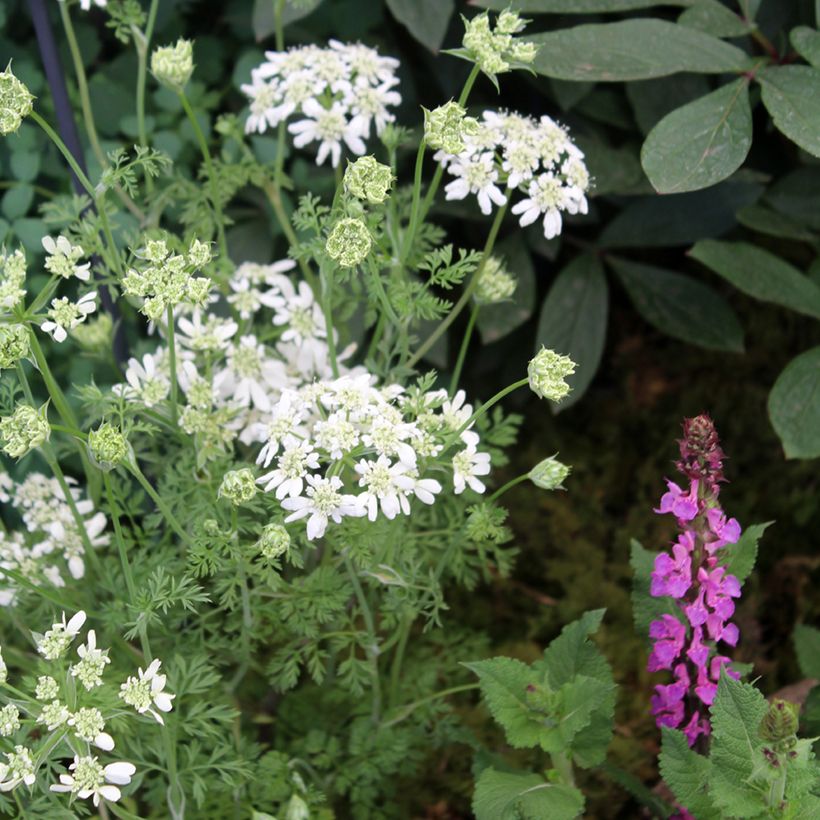

Flowering
Foliage
Plant habit
Botanical data
Orlaya
grandiflora
Apiaceae
White Laceflower
Cultivar or hybrid
Other Thompson and Morgan seeds
Planting and care
Two options for sowing:
1- Sow Orlaya seeds from March to May. Sow on the surface of a seed compost, in pots or trays, and cover with a thin layer of compost or vermiculite. Enclose the sowing in a polythene bag and keep it at a temperature between 15 and 20°C (59 to 68°F). After sowing, do not exclude light as it promotes germination. Keep the surface of the compost moist but not waterlogged; germination usually takes 21 to 30 days.
2- The seeds can also be sown outdoors directly in place, in late summer or early autumn to obtain earlier flowers the following year.
When the young plants are sufficiently developed, transplant them into 7.5 cm (3in) diameter pots or trays. Plant them in the garden, spacing them 30cm (12in) apart.
Cultivation:
Orlaya grandiflora enjoys sun and warmth. It can grow in poor soils and difficult conditions. However, the soil must be well-drained, with a tendency towards limestone or even excessively alkaline. The poorer the soil in nutrients, the smaller the plant will be. In humus-rich and fertile soil, it can reach a height of 70 cm (28in). It develops and flowers easily, sometimes self-seeding spontaneously, allowing for the creation of beautiful natural flower beds that require little maintenance. It is not invasive, as unwanted seedlings can be easily removed.
Sowing period
Intended location
Flower seeds
Haven't found what you were looking for?
Hardiness is the lowest winter temperature a plant can endure without suffering serious damage or even dying. However, hardiness is affected by location (a sheltered area, such as a patio), protection (winter cover) and soil type (hardiness is improved by well-drained soil).

Photo Sharing Terms & Conditions
In order to encourage gardeners to interact and share their experiences, Promesse de fleurs offers various media enabling content to be uploaded onto its Site - in particular via the ‘Photo sharing’ module.
The User agrees to refrain from:
- Posting any content that is illegal, prejudicial, insulting, racist, inciteful to hatred, revisionist, contrary to public decency, that infringes on privacy or on the privacy rights of third parties, in particular the publicity rights of persons and goods, intellectual property rights, or the right to privacy.
- Submitting content on behalf of a third party;
- Impersonate the identity of a third party and/or publish any personal information about a third party;
In general, the User undertakes to refrain from any unethical behaviour.
All Content (in particular text, comments, files, images, photos, videos, creative works, etc.), which may be subject to property or intellectual property rights, image or other private rights, shall remain the property of the User, subject to the limited rights granted by the terms of the licence granted by Promesse de fleurs as stated below. Users are at liberty to publish or not to publish such Content on the Site, notably via the ‘Photo Sharing’ facility, and accept that this Content shall be made public and freely accessible, notably on the Internet.
Users further acknowledge, undertake to have ,and guarantee that they hold all necessary rights and permissions to publish such material on the Site, in particular with regard to the legislation in force pertaining to any privacy, property, intellectual property, image, or contractual rights, or rights of any other nature. By publishing such Content on the Site, Users acknowledge accepting full liability as publishers of the Content within the meaning of the law, and grant Promesse de fleurs, free of charge, an inclusive, worldwide licence for the said Content for the entire duration of its publication, including all reproduction, representation, up/downloading, displaying, performing, transmission, and storage rights.
Users also grant permission for their name to be linked to the Content and accept that this link may not always be made available.
By engaging in posting material, Users consent to their Content becoming automatically accessible on the Internet, in particular on other sites and/or blogs and/or web pages of the Promesse de fleurs site, including in particular social pages and the Promesse de fleurs catalogue.
Users may secure the removal of entrusted content free of charge by issuing a simple request via our contact form.















































